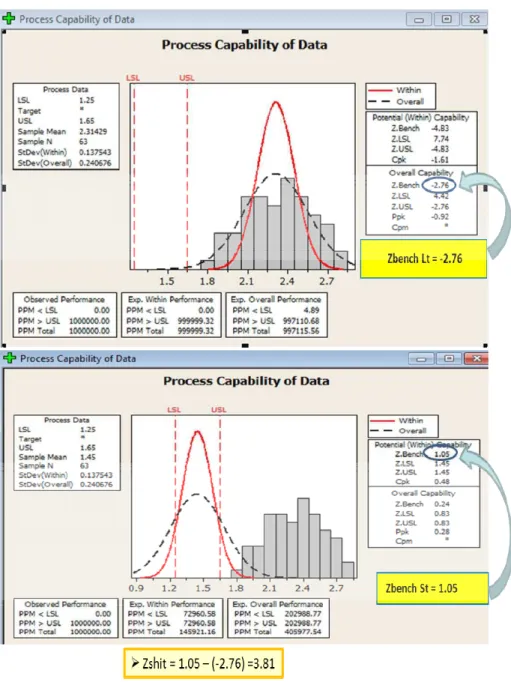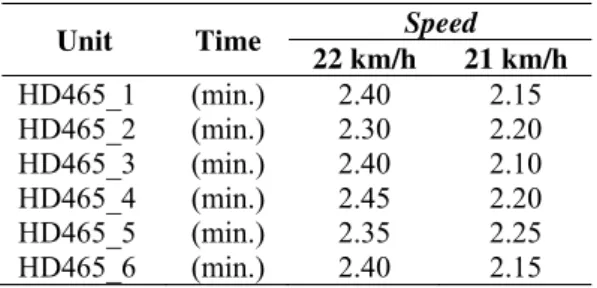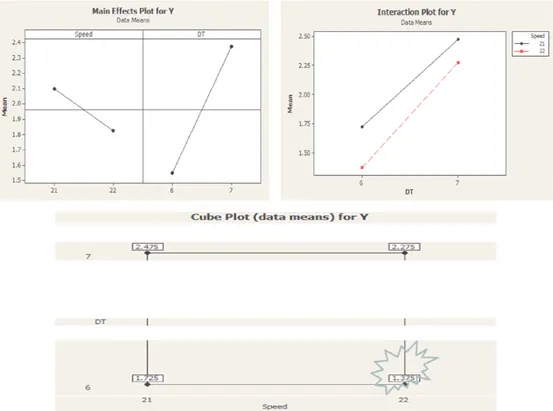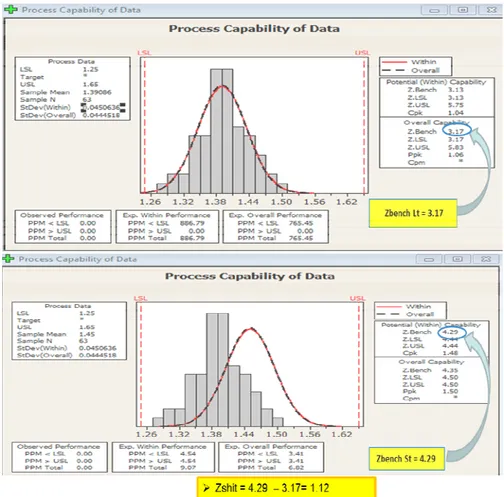REDUCING THE OPERATIONAL STOP TIME
OF HAULLER KOMATSU HD465-7 BY USING
THE SIX SIGMA’S APPROACH IN PT X
Humiras Hardi Purba
11
Master of Industrial Engineering Program, Mercu Buana University Jln. Menteng Raya 29 Jakarta Indonesia
1
hardipurba@yahoo.com
ABSTRACT
An operational stop time is a condition where heavy equipment is not working as usual. It is important to avoid this condition since excessive idling wastes an enormous amount of fuel and money. However, the operational stop time of a dump truck Hauller HD465-7 is 2.83 minutes, which is far above the normal standard. This project aims to optimize the improvement of an operational stop time by using a Six Sigma method with optimize plan selection. This will return the operational stop time to the standard range within 1.25 to 1.65 minutes. These steps of define, measure, analyze, improve, and control are applied to the standardization process according to the rules and criteria established by the Six Sigma. The result found that the Six Sigma’s approach which was applied in PT X has reduced the cost from US$1,105,300 to US$963,000 every month. An improvement have been made to matching fleet by combining six fleet of dump trucks at driving speed of 22 km per hour and the average simulated haul distance was 2,000 meters.
Keywords: stop time, dump truck, six sigma, improvement
INTRODUCTION
Six Sigma is a business strategic management which originally developed by Motorola in 1986 in order to enhance the quality of products through decreasing of product variations on manufacturing operations as they face compete in semiconductor industries. Through the application of the Six Sigma method, Motorolla has acknowledged an award of Malcolm Baldrige in 1988 as the first American’s company which won its prestigious quality’s award (Parsana et al. 2014). Six Sigma consists of a set of process where 99.9996 percent of resulted products are statistically expected to be free defects (3.4 ppm of level of reject or defect). Recently, the success processing rate of 99 percent is no longer being reminded and the world-class companies continue to enhance to provide both services and products perfectly to address zero defects. The main idea of Six Sigma is an approach to design the processes or to improve existing process to gain a very high capability/ability process in favor of near zero defects (Kwak et al. 2006). To illustrate why obtained level of 99 percent of quality is no longer enough, some facts are considered (McClusky, 2000). First, on mail delivery, reaching the quality of 99 percent meaning there are 10,000 mails are lost in every hour. Second, landing at airports for the quality of 99 percent meaning there are two unsafe landed aircraft in every hour. Third, medical surgical for the quality of 99 percent meaning there are 500 patients undergoing surgical errors in every week. Fourth, power plant operations for the quality of 99 percents implies seven hours blackout within a month.
organization requires both flexibility and discipline in solving problems using statistical approach rather than using simple intuition or by trial and error; wider usage of statistical treatments is one of the benefits of Six Sigma method (Pacheco, 2014). Application of Six Sigma’s method is more valuable due to its contribution to the science and practice for particularly reduces waste and provides added values. Six Sigma allows users to identify waste and hidden costs, eliminates defects, increases profit margin, satisfies customers, encourages employee commitment and satisfaction as well as expands businesses (Patil et al, 2015).
The world-class companies within the Fortune 200’s category such as Motorolla, GE, Bank of America, Honeywell, Boeing, Ford and other companies were using the Six Sigma programs to maximize their profits (Raisinghani, 2005 and Kabir et al, 2013). Six Sigma as a management system is applied to ensure that efforts and critical opportunities for improvement are well developed through metric methodology and an applied level is inline with its business strategy. Six Sigma enables an organization to improve quality process by identifying and eliminating the causes of defects and error terms through minimizing variability in manufacturing and business processes (Mittal, 2014). The stages for improve process ability (process capability) regarding Six Sigma method are specifically allowing the standar steps such as define, measure, analyze, improve, and control for interlinked statistical tests. For a particular project within organization of applied of Six Sigma the stage is typically consists of a step-by-step requires for obtain measurable target values i.e. reduces cycle time, decreases air pollution, reduces costs, improves customer satisfaction, and increases profits (Mittal, 2014). It is inevitable, in order to gain benefits, as a results of Six Sigma’s application in an organization or company, would require relatively high of initial investment, but might be offer benefits in long terms including cost savings, generated profits, improved consistency of quality processes, better employee performance, and better service quality and products. Those elements particularly would lead an organization or company to provide a higher customer satisfaction as well as to gain the ultimate goal of organization (Mittal, 2014). The existence of Six Sigma can be seen as a philosophy, business strategy, repair tool, and statistical measurement. Six Sigma is generally a management strategy, culture and change, and the need for organization to build as a whole into company’s strategy plan. Six Sigma activities are focused on reducing the level of defect/failure of product or process (Taneja & Manchanda, 2013).
1980’s period in the United States. The first one is an introduction of mass production of miniaturized electronics, transistor from radio to television, etc., which produce in large quantities for mass-market consumption. Secondly most related to opening of the United States market to foreign products particularly electronic devices made in Japan, which is the driving force to increase the quality of domestic products that was made in America. Both the quality and feature of products are two of the most advantages that made Japanese products are highly attractive to global consomers including American market (Raisinghani, 2005).
In order to response to Japanese foreign market penetration, an effort has been taken to a certain number of policy measures to improve the quality in the 1980’s period. As the results, Ford Motor’s automotive company introduced the quality system of zero defects, Boeing and Bell Telephone applied the concept of total quality management, Honeywell electronics and Fairchild developed the quality cycle concept that allows the average employee to engage more seriously by finding out what its customers need and enabling employees to deliver customer-oriented promises successfully (Raisinghani, 2005). The Nation has also seen the significant importance of the products and services. The Malcolm Baldrige National Quality Award (MBNQA) was established in 1987 by the U.S. Congress in an effort to promote quality improvement initiatives in U.S. businesses. The award program was named after former Secretary of Commerce, Malcolm Baldrige, and was designed and managed by the National Institute of Standards and Technology (NIST) with the help of private companies. Baldrige National Quality Improvement Act of 1987 (Public Law 100-107) signed into The Baldrige National Quality Award Program that was created by Congress through the Malcolm law by President Reagan on August 20, 1987.
METHODS
Define
The earth-moving dump truck vehicle consists of five steps (Figure 1): (1) Loaded stop time: the time it takes the loading equipment to load the dump truck. (2) Loaded drive time: the time to travel to the dump site. (3) Unloaded stop time: the time required to unload. (4) Operational drive time: the time to travel to the load site. (5) Operational stop time: the waste time in waiting between loads.
An operational stop (wait) conditions creates underutilized trucks and look for opportunities to reduce wait times using the Six Sigma tool. Truck wait time occurs when the truck must wait to be loaded or to dump because of nonsynchronization in the haulage system.
Figure 1 Process Flow Houling Activity
Operational stop times can be reduced by improving dump truck allocation and supervision and by dispatching systems. The average operational stop time of Komatsu HD 465-7 is 2.83 minutes, higher than 1.40 minutes meets the improvement target. The goals and targets examined here are those related to the cost quality and productivity (CQP) aspects with a breakthrough idea is to synchronize the improvement of a mixed fleet of Komatsu HD 465-7 and excavator Komatsu PC1250-7.
Measurement
Figure 2 Gauge R&R Operational Stop Time
In addition to determining improvement direction, it is important to know or determine its current position for represented block diagram and to calculate the values of Z-LT, Z-ST, and Z-Shift on the technical diagram control vs. process control.
The results show that the values of Z-ST and Z-Shift are 1.05 and 3.81, respectively; they indicate a lack of process control and lack technical knowledge and allowing for continual improvement stage as shown in Figure 4.
Figure 4 Process Capability before Improvement
Analyze
Measurement results show that the potential factor input [F(x)] as measured this study effect on output (Y) of increases in the operational stop time is the speed for loaded and operational trucks, the number of haulage units, and the skill of the operator. Furthermore, a statistical analysis was conducted to determine the vital few significant factors out of a large potential factors being estimated.
Table 1 Measurement Resultof of Operational Stop Time with Speed 21km/h & 22km/h
Unit Time Speed
22 km/h 21 km/h
HD465_1 (min.) 2.40 2.15 HD465_2 (min.) 2.30 2.20 HD465_3 (min.) 2.40 2.10 HD465_4 (min.) 2.45 2.20 HD465_5 (min.) 2.35 2.25 HD465_6 (min.) 2.40 2.15
Hypothesis:
Ho = speed not affect operational stop time. H1 = speed affect operational stop time.
P-Value < 0.05, “Reject Ho” (speed is vital factor).
X2: number of dump truck vs operational stop time testing
Table 2 Measurement Result of Operational Stop Time with dump truck (DT) 6 &7
Unit Time Number of DT
6 7
HD465_1 (min.) 1.20 2.51 HD465_2 (min.) 1.40 2.55 HD465_3 (min.) 1.30 2.50 HD465_4 (min.) 1.40 2.45 HD465_5 (min.) 1.35 2.55 HD465_6 (min.) 1.50 2.61
Hypothesis:
P-Value < 0.05, “Reject Ho” (number of dump truck is vital factor)
X3: operator skill vs operational stop time testing
Table 3 Measurement of Operational Stop Time with Operator 1 and Operator 2
Unit Time Operator 1 Operator 2
HD465_1 (min.) 2.51 2.48 HD465_2 (min.) 2.45 2.52 HD465_3 (min.) 2.55 2.50 HD465_4 (min.) 2.40 2.45 HD465_5 (min.) 2.45 2.38 HD465_6 (min.) 2.50 2.40 HD465_7 (min.) 2.50 2.45
Hypothesis:
Ho = operator excavator skill not affect operational stop time.
H1 = operator excavator skill affect operational stop time.
Improvement
The concept of improving results and performance on a continual basis is universally hailed as a great idea. First off, in order to improve continuously, an organization or companies have to improve initially. Based on the test results for the analyze step, it can be seen that there are only two things which might be worth influencing an operational stop time: the speed for loaded and operational truck and the number of haulage units. Under the travel condition and moving at a constant speed, each vehicle is moving at 21 and 22 km/h, the combined of the six and seven vehicles. To obtain the most appropriate combination, improvement steps have been done using the design of experiment (DoE) techniques.
Figure 5 Main Effect Plot DT 6&7 with Speed 21km/h & 22km/h
According to the optimal value, the optimal improvement result can be obtained by only combining a speed of 22 km/h and a number fleet of 6 units. In these combination exercises, the average operational stop time is 1.375 minutes, as shown in Figure 5.
Control
Six Sigma emphasizes the control phase because previous attempts at improving performance repeatly demonstrated that the whole process is complex and that hard-earned gains slip away if the process is left to itself. A well-designed process exhibits inherent self-control, while a poorly designed process requires frequent external control and adjustment to meet requirements.
In order to apply the DMAIC tools developed, the organization or companies need to put this information into handbook of the standard of operational stopped time: 1.25 to 1.65 minutes are required for haul lengths of 2,000 meter, with a fleet of 6 dump trucks and a uniform velocity of 22 km/h.
RESULTS AND DISCUSSIONS
The purpose of the Six Sigma process is to identify and contain the vital views variables. In order to undertake hypothesis, a test is needed to express the research hypothesis as a null and alternative hypothesis. The null hypothesis and alternative hypothesis are statements regarding the differences or effects that occur in the population. Sample is used to test which statement (i.e., the null hypothesis or alternative hypothesis) is most likely (although technically, we test the evidence against the null hypothesis). The level of statistical significance is often expressed as the so-called p-value.
The cube plot shown in Figure 4 expresses the relationship between average speed, the vehicle fleet size, and operational stop times. For example, an operational stop time at 1.75 minutes requires the average speed of 21 km/jam and a fleet of 6 vehicles. With the figures = 1.375; 2.275; and 2.475 the corresponding initial value would be 22 and 6; 22 and 7; and 21 and 6, respectively. These exercise results suggest that only under a combination of speed of 22 km/h and a fleet size of 6 vehicles yielded the most optimal improvement with an operational stop time around 1.375 minutes.
As shown in Figure 7, the initial values of Z-ST and Z-shift are 1.05 and 3.81 (quadrant A), respectively, that has changed by improving steps. The new values of Z-ST and Z-shift are 4.29 and 1.12, respectively, (values of Z-ST - Z-LT) indicate that operational stop time and their related quantity variables have been performed. Furthermore, the process of capability analysis entails comparing the performance of a process against its specifications. We say that a process is capable if, virtually, all of the possible variable values fall within the specification limits. Graphically, we assess process capability by plotting the process specification limits on a four block diagram as shown in Figure 8.
Figure 8 Process Capability Plotting on Four Block Diagram
If a value of capability process is within quadrant A, it means the problems is strongly related to poor technology and control aspects. The capability process that remains in quadrant B means that the technology is appropriate but less controlling. By contrast, an organization or company within quadrant C means that it lacks proper implementation of technologies but has appropriate controls to the user. The ideal one is given by the quadrant D (world class), where the capability process related to the technology implementation and control measures are fully integrated. Six Sigma as a management system can be easily implemented to raise productivity, increase the bottom line, improve quality and the customer experience, and increase financial savings.
CONCLUSIONS
REFERENCES
Anthony, J. (2011). Reflective Practice Six Sigma vs Lean. International Journal of Productivity and Performance Management, 60(2), 185-190.
Kabir, M.E., Boby, S.M.M.I., & Lutfi, M. (2013). Productivity Improvement by using Six-Sigma. International Journal of Engineering and Technology, 3(12), 1506-1084.
Kwak, Y. H., & Anbari, F. T. (2006). Benefits, obstacles, and future of six sigma approach. Technovation, 26, 708-715.
McClusky, B. (2000), The rise, fall and revival of Six Sigma quality: measuring business excellence. The Journal of Business Performance Measurement, 4(2), 6-17.
Mittal, M. (2014). Latest Trend in Management - Six Sigma. Gian Jyoti E-Journal, 4(1), 32-38.
Pacheco, D. A. J. (2014). Theory of Constraints and Six Sigma: Investigating Differences and Similarities for Continuous Improvement. Independent Journal of Management & Production, 5(2), 331-343.
Parsana, T. S., & Desai D. A., (2014). A Review: Six Sigma Implementation Practices in Indian Manufacturing SMEs. International Journal of Engineering Research and Applications, 4(3), 663-673.
Patil, S. D., Ganganallimath, M. M., Math, R. B., & Karigar, Y. (2015). Application of Six Sigma Method to Reduce Defects in Green Sand Casting Process: A Case Study. International Journal on Recent Technologies in Mechanical and Electrical Engineering, 2(6), 37-42.
Raisinghani, M.S. (2005). Six Sigma: concepts, tools, and applications. Industrial Management & Data Systems, 105(4), 491-505.







